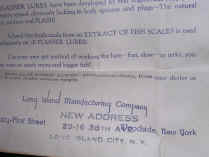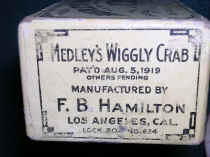|
Leeper's Bass Bait, Fredonia, Ky. Henry Leeper patented this well-made lure in 1919 and received another patent in 1921. It was designed so anglers could tie the lure on either end, creating different action in the water. This rare box mentions a special introductory price for this lure, which would make it the first Leeper's box. Notice that the label doesn't mention Kentucky. |
 |
|
Leeper's Bass Bait, Patented, Signed. This exquisite, boxed Leeper's Bass Bait is the hard-to-find large size. It is mint in the box and has wonderful two-color papers with a hand-lettered postscript that it has been patented. I would be willing to bet this was penned by Leeper himself! This fine lure was acquired from a visitor to this website from Rugby, England. |
 |
Limbo Legs, LeVan Industries, Chicago This unique, glass eyed Lim-Bo Legs frog was made by LeVan Industries. The Lim-Bo Legs was also called Limbo Legs. The Limbo Legs was found in surface and diving models (this Limbo Legs is a diver) and all were painted in beautiful frog spot. They had hardware to which leather legs could be attached. Lim-bo Legs frogs are from the 30s. |
 |
|
Lockhart Water Witch, Galesburg, Mich. Lockharts are early Michigan classics. These no-eyed lures date to the 1907-1915 era and have a hole through the chin much like the later Coldwater lures. Wagtails and Lockhart Water Witch lures have an unusual wire hook hardware not found on any other lures. This early maroon box is the only one of its kind known, as are these papers. |
 |
Lockhart's Wagtail Witch, Galesburg This Lockhart's Wagtail Witch is in the later, more typical white box with red lettering. This one carried the 1909 patent date for the design patent issued to its maker, Edward J. Lockhart. His wife, Evelyn, also helped produce these interesting early lures. |
 |
Wagtail Witch, Michigan This is another Lockhart bait and box that dates to the 1910-1913 era. Note that the picture on the box faces in the opposite direction as the example above, and note that the lure is slightly different, having an external groove instead of the hole through the chin. These are wonderful lures. |
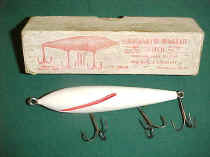 |
There are many styles and colors of Lockart lures and a collection of them is something to be proud of. |
 |
|
Long Island Flasher, New York These well-made baits from the 1930s have milky glass eyes and a patented finish which, according to the box literature, was made from actual fish scales that give the lure its lustrous finish! The diving lip is stamped with its name. |
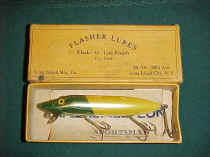 |
|
Flasher Life Life Lures, New York This is a rare, early introductory box and paper for these beautiful lures, along with a closeup of their wonderful, egg-yolk eyes. Note the discussion in paperwork about the claim that Long Island Flasher lures are made from fish scales. The lures are so shiny they are difficult to photograph without a lot of camera glare. |
 |
 |
|
|
Long Island Flasher, Plunker Style Finished in the same fish-scale extract finish as the lure above, this Flasher Lure resembles a Heddon Basser, and has no diving lip. The milky glass eyes are unlike those from any other maker. Their origin is a mystery to me. |
 |
|
The Luminastic Perma Bait was made in the 1940s by Luminastic Products Co., 901 Saratoga St., Newport, Kentucky. It is a heavy, dense pyralin maerial with large glass eyes. It is identical in shape to a Moonlight Pikaroon. This Luminastic Perma Bait is mint in the original box. |
 |
 |
|
Day Or Night, R.S.T. Markham, Mich. You are looking at an important box and lure. We don't know who R.S.T. Markham was but we know the No. 22 Day or Night Bait dates to the pre-1907 years and was made in Battle Creek, Mich. We suspect this may have been the predecessor of - or inspiration for - the famous Moonblight No. 1 Floating Bait. Note the Moonlight line-tie hardware. |
 |
|
Magic Minnow, Brookline, Mass. The Magic Minnow is a cheap, hollow metal lure with scales and other featured molded into the body. They were made under various names in the 1930s, and most had painted-on eyes and red gill marks. The diving lip is soldered on. |
 |
Martin's Lizard, Drumright, Okla. These wooden, glass-eyed plugs emerged in the late 1930s and were made on into the mid-1940s. The maker, Jack Martin, wrote in the box literature that all the painting was done by hand, and that replacement tail spinners were available. The catalog lists 32 separate colors! |
 |
|
McCormic Mermaid, Michigan The McCormic Mermaid was patented in 1917 by J.T. McCormic of Kalamazoo, Mich. "Like a Thing Bewitched, It Seems to Weave, a Weird, Enchanting Spell" is one of my favorite box jingles. Shakespeare absorbed the Mermaid into its product line in the early 1920s. |
 |
Medley's Wiggly Crab, Los Angeles Harry L. Medley of Los Angeles patented the Medley's Wiggly Crab in 1919. This is the rare first box, which contains a lure stamped "Patd.," (later lures carry the 1919 date). Note the wonderful graphics in this exquisite Medley's Wiggly Crab picture box. This rare piece was acquired from a visitor to this website who found it in Burbank, Calif. |
 |
 |
|
|
Medley's Wiggly Crawfish, Calif. Harry L. Medley later transferred his business to F.B. Hamilton, who moved the operation to Ohio. This Medley's Wiggly Crawfish lure has the 1919 pat. date on the diving lip. The antennas on these lures were horsehair, and are usually missing, even on unfished lures. Later boxes say Medley's Wiggly Crawfish; early ones say Medley's Wiggly Crab. |
 |
|
Herb Mills Tackle, Lima, Ohio The Herb Mills Tackle Co. was in business in the early 1930s and made some high-quality glass-eyed lures. The mint Acrobat in this box has Herb's name stenciled in the chin. Boxes for this short-lived line of lures are rare indeed. |
 |
|
Herb Mills, Piqua, Ohio The Herb Mills Chief Teazum is a torpedo-type surface bait with wonderful hardware and flat-bottom cups. Notice the unique triangular bushings on the propellers. "Heap Good Bait, Bringum Big Fish." This box is the only one I've ever heard of, and was found in a town near Piqua. It is believed Mills operated first in Piqua and later moved to Lima. |
 |
Herb Mills Crawdad The wooden Crawdad is one of the best critter lures ever made. The body is nicely turned and the metal diving lip is stamped "HERB MILLS." The catalog literature lists this lure as being available only in "Luminous Crawdad" finish, which refers to the blended luminous belly. The eyes are black glass beads and the feelers are silk and deerhair. |
 |
Herb Mills Surface Minnow The wonderful glass eyed Herb Mills Surface Minnow is in a yellow box that differs from the white box two frames up in that it is marked as having been made in Piqua. The white box above is labeled Lima, Ohio. Aside from that, the two boxes are nearly identical. Note the huge, floppy props. |
 |
Meyer Baby Manhattan, N.Y. This unusual "Baby Manhattan" doesn't have the metal keel often found on medium and large models. This circa 1910-12 revolving head lure was made by S.D. Meyer and is similar to the Decker baits of the same era and region. The box features a greenish lithographed design identical to the background paper on heddon Wiggle King boxes. |
 |
Mills Yellow Kid, New York The William Mills Tackle Co. of New York was an early sporting goods outfitter that offered a revolving head bait similar to Decker, Hinckley, Horrocks-Ibbotson and others of the pre-teen years. The Mills Yellow Kid Plug Bait is hand painted and its box is blue on the bottom and maroon on top. Note the screw-eye hardware. |
|
|
Miller's Reversible Spinner, N.Y. The Union Springs Specialty Co. of Cayuga Springs, N.Y. made the Miller's Reversible lures around 1914. The Miller's Reversible Spinner featured an elaborate set of ornate propellers. The company also made a wooden lure - called Miller's Original Wood Minnow - with similar spinners. |
 |
|
Miller's Original Wood Minnow The Union Springs Specialty Co. of Cayuga Springs, N.Y. made this all-time classic in 1914. The Miller's Original Wood Minnow came in three colors and all had the Reversible Spinner. This Miller's Reversible box has a flyer showing W.H. Miller with a string of fish he caught in Cayuga Lake in 1915. It is one of many famous New York lures. |
 |
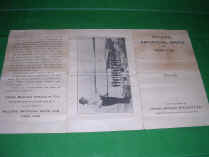 |
|
Mitey Atom, Dallas, Texas The Mitey Atom dates to the early 1940s and may have been a forerunner of the more common Bomber lures made in Gainesville, Texas. The Atom, shaped like a bomb, was said to "blast the big boys out of their bomb shelters." The wooden lures have unique cup rig hook hangers, and were produced by Thompson-Moore Tackle Co. of Dallas |

